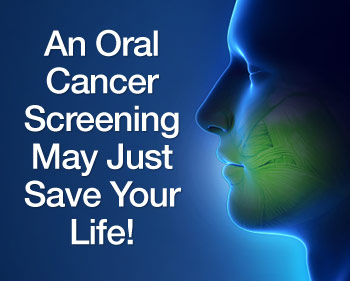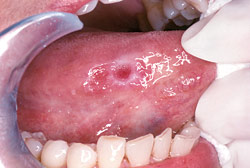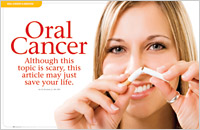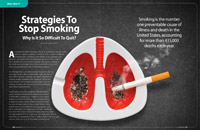How serious a malady is oral cancer? According to the American Cancer Society, about 110 people in the United States will be diagnosed with this disease every day. Of those, about one in three will be under 55 years of age. The good news is the 5-year survival rate for this type of cancer — when detected in its early stages — is better than 80%.
 Unfortunately, oral cancer is not usually found so early. When it's discovered at a later stage, the odds of 5-year survival drop below 60%. In fact, the National Institutes of Health estimates that one in four individuals diagnosed with oral cancer will not survive because their diagnosis and treatment were delayed. This shows how important it is to detect oral cancer as early as possible.
Unfortunately, oral cancer is not usually found so early. When it's discovered at a later stage, the odds of 5-year survival drop below 60%. In fact, the National Institutes of Health estimates that one in four individuals diagnosed with oral cancer will not survive because their diagnosis and treatment were delayed. This shows how important it is to detect oral cancer as early as possible.
Who's most at risk for oral cancer? While genetics clearly influences who will get the disease, lifestyle factors also play a significant role. Users of tobacco in any form, and moderate to heavy consumers of alcohol, are up to nine times more likely to develop oral cancer than non-users. As is the case with skin cancers, prolonged sun exposure has been linked to cancers of the lip. A diet low in fruits and vegetables is also associated with increased risk.
While most people who get oral cancer are over 40 years of age, a growing number of younger people are diagnosed with the disease every year. This disturbing trend is thought to be the result of the Human Papilloma Virus (HPV16), which is sexually transmitted. So today, oral cancer screenings are important not just for older folks, but for everyone.
How is Oral Cancer Diagnosed?
 The simplest way to test for oral cancer is by a visual inspection of the mouth, lips, tongue, and surrounding area. This is generally performed in our office during your routine dental examination. We will check the tissues outside and inside your mouth for any signs of possible disease, and gently move your tongue aside for a look at areas that are harder to see. We may also feel for lumps in your mouth, fact, and throat.
The simplest way to test for oral cancer is by a visual inspection of the mouth, lips, tongue, and surrounding area. This is generally performed in our office during your routine dental examination. We will check the tissues outside and inside your mouth for any signs of possible disease, and gently move your tongue aside for a look at areas that are harder to see. We may also feel for lumps in your mouth, fact, and throat.
To supplement the visual and tactile examination, several high-tech systems are in use that may make oral cancer easier to detect. All of these systems involve the use of special light sources to help find potentially diseased cells. The devices produce light of specific wavelengths (sometimes in combination with a mouth rinse), which is thought to aid in identifying tissue that may be cancerous or pre-cancerous.
What Happens Next?
Like typical mouth sores or temporary discolorations, the majority of suspicious areas will likely turn out to be benign. But to make sure, a small sample of any tissues which are suspected of carrying the disease will be sent to a laboratory for biopsy. A laboratory biopsy is the only certain way to know if oral cancer is present.
Early detection and treatment has a proven value in increasing survival rates for this serious malady. To offer our patients the greatest chance of finding the disease in its early stages, we keep abreast of current research in the area and utilize the most appropriate and effective high-tech systems for oral cancer detection.
Related Articles

Oral Cancer This article may just save your life. Learn how to notice any unusual lesions (sores or ulcers) anywhere in your mouth that do not heal within two-three weeks. Early detection is key... Read Article

Strategies To Stop Smoking Cigarette smoking is the number one preventable cause of illness and death. Quitting smoking could prevent a large number of diseases and deaths each year. Many smokers find it difficult to stop, a fact that is confirmed by the staggering rate of relapse. Given the fact that cigarette smoking is a learned behavior that is reinforced over time, it makes sense that to be successful in quitting, you must “unlearn” this behavior. Here are some suggested ways to learn how... Read Article